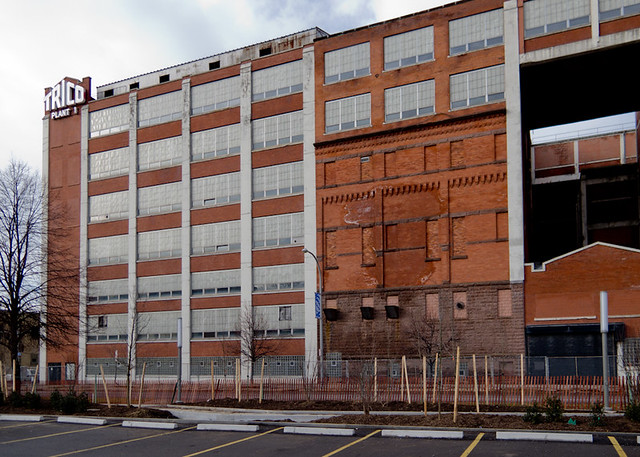Buffalo’s Talking Proud campaign of the 1980s was a huge booster for the city in a time where it was bombarded nationally with negative comments, sometimes even coming from the city’s own residents. It took years to develop and almost never happened, but thanks to the perseverance of Pat Donlon the long road to actually launching the campaign was a success.
The concept for the Talking Proud campaign has its roots in the late 1970s when Fred Dentinger had finally had enough about all the negative comments about Buffalo. He served as chairman of the Buffalo Area Chamber of Commerce between 1977 and 1978 and believed in defending Buffalo against all criticisms. Dentinger never got a chance to start the campaign because of his other duties, but primarily because he had to deal with the Blizzard of 1977.
 |
| Pat Donlon, wears his Talking Proud polo and displays the Talking Proud board game |
Dave Smith, who succeeded Chuck Light as the president of the Buffalo Area Chamber of Commerce, shared Dentinger’s defensive attitude and sought to set the record straight. The board of directors instructed him to create a program which would improve Buffalo’s self-image problem. Donlon, the public relations director for the Chamber, was charged with creating the Talking Proud campaign when Smith was recruited.
There had already been a pride boosting campaign for Buffalo in the 1960s, but it had very little substance and was not effective. It was primarily a “feel-good” campaign with a slogan stating, “Boost Buffalo: It’s Good For You.” The campaign only ran for a few months and then faded into obscurity.
Donlon used the 1960s campaign as a sort of template, but injected more substance into the Talking Proud campaign to ensure it stuck. The first attempt at gathering a group of agencies and creative people fell on its face because people rarely showed up or sent their junior staff who were unqualified to take on the challenge. Donlon informed Smith the approach wasn’t working and suggested the only way to get traction was to make an initial investment and assume the role of a client.
The change proved effective and the campaign was beginning to finally move in the right direction. They assembled a plan and had a competition between four finalists to determine which would be best suited for the campaign. Ultimately, they settled on Alden Schutte who proposed taking a survey of the Buffalo area residents to gauge their perception about the city so an effective campaign could be created.
The change proved effective and the campaign was beginning to finally move in the right direction. They assembled a plan and had a competition between four finalists to determine which would be best suited for the campaign. Ultimately, they settled on Alden Schutte who proposed taking a survey of the Buffalo area residents to gauge their perception about the city so an effective campaign could be created.
When the Talking Proud campaign officially launched in September 1980 it was a huge success. Donlon remembers the launch well. “As we were leaving the hotel, Dave Smith said to me, ‘A month from now we’ll either be heroes or we’ll be looking for new jobs.’ Needless to say, we both remained gainfully employed at the Chamber a month later.” There were radio spots, commercials, and of course the famed Talking Proud jingle. There was also a lot of different merchandise that followed including tens of thousands of Talking Proud pins and the Talking Proud board game to name a few.
Even though the campaign was a success, Buffalo still faced criticism. “In a morning show on CBS, Morley Safer took a shot at Buffalo along the lines of questioning why anyone would want to build a new hotel [the Hilton] on the waterfront. He cited Love Canal and made remarks that the region was contaminated with dangerous waste chemicals,” said Donlon.
Talking Proud Jingle played over the new commercial for the Buffalo: For Real campaign
Stakeholders, news reporters, and residents were outraged at Safer’s comments. Roger Parkinson the publisher of the Courier-Express extended an invitation to Safer to come to Buffalo to prove him wrong. Safer obliged, but stated he stood by his comments during an impromptu news conference upon his arrival. Donlon remembers, “Out of earshot of reporters, Safer noted that he was impressed with the treatment he was being accorded. He added that there might be something valuable in knocking other cities; perhaps he would turn his attention to Paris or London next time, in anticipation of red-carpet treatment there.”
After his stay in Buffalo, Safer publically admitted that he was completely mistaken in his previous comments and retracted his initial statement. He was gracious that residents treated him well despite his comments and had a wonderful time taking in the sites and enjoying the city.
Another crucial element to the success of Talking Proud was the Buffalo Bills. “Thanks to the Bills, Talking
Proud achieved national exposure in TV coverage,” said Donlon, “We received inquiries even from cities in other countries, especially Canada.” The jingle was played at the end of the first quarter at a Bills game and the fans went wild because just before the quarter ended the Bills quarterback completed a touchdown pass. From then on, the fans associated the sound clip with the team’s success and it was played regularly at the games.
The Talking Proud campaign was recognized with the top award from the American Chamber of Commerce Executives Association's Communications Council in 1981. Syracuse and Rochester used Talking Proud as a model for their own self-image campaigns and were similarly recognized the following two years. It lives on today, more than 30 years after its launch. Drivers along Delaware Avenue can see advance-warning street signs bearing the Talking Proud logo.
_________________________________________________________________________________________________


